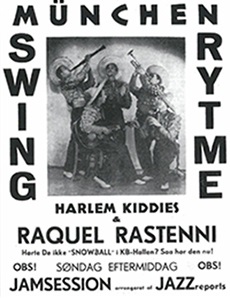The mere notion of an Afro-Danish orchestra with three black musicians and a Jewish woman that sold out all the biggest Copenhagen venues during the German occupation – when the Nazis were practically goose-stepping through the streets – is surreal,” says lecturer Anne Dvinge from the Department of Arts and Cultural Studies.
Anne Dvinge has just published an article about Harlem Kiddies entitled ’Between the Devil and the Deep Blue Sea: Afro-Danish jazz band Harlem Kiddies and discourses of race and resistance in 1940s Denmark’ in the international journal African and Black Diaspora.
In the article, she describes how the Harlem Kiddies, which consisted of Afro-Danish musicians Jimmy and Johnny Campbell, Kaj Timmermann, and Jewish singer Raquel Rastenni, became a major hit during World War II. And she explains how a wartime orchestra with this extraordinary line-up could become so popular.
A symbol of resistance

The Danish jazz scene flourished during the German occupation of Denmark, and the period has become known as the golden age of Danish jazz. The popularity of Danish jazz in this period can be attributed to the fact that foreign music did not make its way into Denmark during the war, which meant that Danish jazz had to be self-sufficient. Also, because of its American roots, jazz became a symbol of protest and resistance to the Nazis.
“Listening to an orchestra that they knew the Nazis would not like gave audiences a sense of being rebellious. However, when it comes to the discussion of the musicians’ colour, audiences were divided: some felt that the music and the orchestra were good because the musicians were black. And some felt that the music was not black enough. Clearly, for jazz music to be authentic it had to be black,” Anne Dvinge explains.
But apart from the colour of their skin, their ability as musicians played a part in their huge popularity:
“They played extremely well, and their music is much more interesting than most other golden age jazz. Although their music is not highly inventive, it is has tremendous drive – even by modern standards.”
Not arty enough for the elite
After the war, the Harlem Kiddies faded into oblivion, for a number of reasons: jazz was increasingly seen as an art form, whereas the members of Harlem Kiddies saw themselves as entertainers and had started their careers as tap dancers and bicycle artists. And that, according to Anne Dvinge, was considered poor taste by the elite.

“The Harlem Kiddies do not fit into the story of jazz as an art form, so I see my research as a vindication of the orchestra and a way of giving them their rightful place in the history of Danish jazz. It is also interesting that the Harlem Kiddies do not even seem to belong in the category ‘traditional golden age jazz’. Golden age jazz is the most celebrated jazz genre in Denmark and has even made it into the official art canon, but is it also one of the most insular periods in Danish music history,” Anne Dvinge points out and goes on:
“Even though the boys from Harlem Kiddies were Danish born and bred, they were not part of the very tight golden age jazz circles, and their paradoxical success shows us that the notion of golden age jazz as particularly Danish and homogenous is false. The story of the Harlem Kiddies is thus a corrective to the notion of Danish culture as homogenous and monolithic,” Anne Dvinge concludes.
Header Image : Headquarters of the Schalburg Corps, a Danish SS unit, after 1943. The occupied building is the lodge of the Danish Order of Freemasons located on Blegdamsvej, Copenhagen. Credit : WikiPedia
Contributing Source : University of Copenhagen






